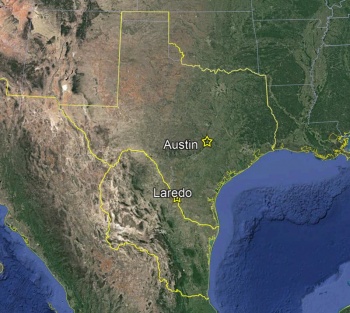Rio Grande
| República del Río Grande | ||
|---|---|---|
| Republic of the Rio Grande | ||
| Motto | "El río da vida" | |
| Anthem | "A partir de Saltillo a Laredo" | |
| Capital | Nuevo Laredo | |
| Largest City | Monterrey | |
| Official language | Spanish | |
| Recognised language | English | |
| Demographics | Latino | 86% |
| European | 9% | |
| Other | 5% | |
| Demonym(s) | Riograndense | |
| Rio Grandean | ||
| Government | Unitary Presidential | |
| Constitutional republic | ||
| President | Nallely González y Luna de Gómez | |
| Congress | Senate | |
| Chamber of Deputies | ||
| Formation | Independence | 2 February, 1848 |
| Open Borders Tex | 1974 | |
| Geography | Total | 295,968sqkm |
| Coastline | ||
| Highest Elevation | 3,710m | |
| Population | 2020 Census | 12,264,664 |
| 2015 Census | 11,516,117 | |
| Density | 41.4/km2 | |
| Economy | GDP (PPP) 2020 | $310.3 billion |
| Per capita | $25,300 | |
| HDI (2016) | ||
| Currency | Peso | |
| Time zone | UTC -6 (DST not observed) | |
| Date format | dd/MMM/yyyy | |
| Drives on the | Right | |
| Internet TLD | .rg | |
| Calling code | +11 | |
The Rio Grande Republic closely shadows Texas and its independence movement, gaining independence in 1848 with help from the Mexican-American War. Spanish and English are the official languages of Rio Grande.
Rio Grande and Texas have an open-borders policy to promote economic prosperity between the two countries. Despite increased prosperity, Rio Grande is still far behind Texas, with its average GDP (PPP) per capita at $25,300, whereas Texas' is $63,000.
History
Revolution and Independence
Santa Anna signed Treaties of Velasco, which Mexico refuses to ratify, though both sides agree to a temporary armistice. However, Mexico warned Texas that joining the United States would result in another war. Texas agreed to these terms. Santa Anna was released back to Mexico, arriving in Veracruz on 7 June 1836 (rel. 1 June from Velasco). Upon return to Mexico, Santa Anna petitioned for Texas' independence before Mexican Congress, though it did not pass.
Texas and Mexico were still hostile towards each other and had continued border skrimishes, but war did not resume.
On 17 January 1840, when the Rio Grande Republic declared its independence, Mexico was not able to respond quickly nor effectively. Texas desired a buffer zone between them and Mexico, secretly sending troops and assistance. The revolution in Rio Grande was slow, with key battles occuring months apart. The pivotal Battle of Saltillo, where Ráfael Vásquez's 800 strong force was decimated at a hacienda, losing 600 men while the Texians and allies lost only 8, emerged as a victory for Rio Grande. This victory was a boost in morale to revolutionaries in Rio Grande and resulted in an increase of enslistments and support for the republic. However, Mexican forces had built up and by March 1841 after several major losses, the majority of Riograndense forces were captured and imprisioned, killed in battle, or deserted.
With the advent of the Mexican-American war, beginning in 1846, several major battles in Riograndense territory (Monterrey, Buena Vista) inspired revolutionaries to take up arms once again, alongside the US, in their fight for independence. The US, eager for allies that would be of use in Mexico, agreed to lead them. Riograndense forces steadily gained strength as the war moved through Rio Grande territory and into Mexico.
With the ending of the war, Mexico, Rio Grande, Texas, and the United States were present at Guadalupe-Hidalgo, where three separate treaties were signed. The first and second acknowledging the full independence of Texas and Rio Grande. The third ending the Mexican-American War and resulting in the Mexican cession.
When Rio Grande signed at the Treaty of Guadalupe-Hidalgo, it was then that Texas and Rio Grande realised that they had an overlapping land claim. It was agreed upon by the Rio Grande that Texas would be entitled to its land, merely due to the timeline of events, Texas having claimed the border to the Rio Grande River before the Rio Grande Republic even existed. However, after the 1849 Texian Cession (where Texas sold it's redundant land claims to the United States), Texas offered Rio Grande a small monetary compensation to formally resolve the matter. While the payment given by Texas was certainly not as much as the land claim was worth, the gesture was well received and a welcome financial boost to the poor republic.
Mexico, which was dealing with the after-effects of the Mexican-American War, was preparing for the possibility of losing more territory when James Gadsden began talks of purchasing land to the south of the Mexican Cession to build a trans-continental railroad. The proposed 'Gadsden Purchase' did not make it past the US Senate, the primary reason being that Texas was an obstacle that would make a southern trans-continental railroad unfeasible and unnecessary, though financially-strapped Mexico would have welcomed the additional influx of money.
Nearly fifty years after the Treaty of Velasco, Texas had a strong desire to revisit and repair relations with Mexico who still viewed Texas somewhat unfavourably. This formed the impetus of the Rio Grande Treaty of 1876, signed by Mexico, Rio Grande, and Texas. This treaty promoted economic cooperation and a mutual defence agreement (though this clause was never invoked).
20th Century
21st Century
Geography
Climate
Government and Politics
Government
The current Rio Grandense government is heaviliy based on that of its predecessor state, Mexico.
The President of Rio Grande serves for 6 years of a single term, with no possibility for reelection. Senators and Deputies serve 3 year terms, non-consecutive, though there is no term limit.
Law
Foreign Relations
Rio Grande
Mexico
Military
Administrative Divisions
Main Article: Administrative Divisions of Rio Grande
There are three states: Tamaulipas, Nuevo León, and Coahuila. Within these three states, there are a total of 132 municipalities (43 TAM), (51 NLE), (38 COA).
Economy
Coahuila is home to massive coal reserves, of which the majority mined is exported to Mexico.
Tamaulipas' economy comes primarily from agriculture. Around Ciudad Victoria, logging is common as well.
Nuevo Leon is highly industrialised, as is Saltillo in Coahuila. Most manufacturing and industry is based in Monterrey or Saltillo.
Transport
Road Transport
Rio Grande has a basic road and highway system.
Railways
Ferrocarril de Rio Grande is the national railway network of Rio Grande. It is headquartered in Laredo.
The Texas and Rio Grande Railroad, headquartered in Dos Laredos, is the second largest railway network in Rio Grande.
Texas, Mexican and Pacific Railroad operates a connection which, originating from Jimenez, connects to Saltillo v. Monclova.
Air Transport
Aerrio is the flag carrier of Rio Grande.
SARE is an airline based in Monterrey.
Water Transport
Demographics
Cities, towns, and metropolitan areas
Rio Grande has 1 city with the population exceeding 1 million, Monterrey.
The Monterrey Metropolitan Area is home to 4.5 million Riograndense, nearly half of the population of Rio Grande.
As well, there are 4 international metropolitan areas with greater than 1 million people (combined):
- Torreón-Gómez Palacio (Torreón,RGR - Gómez Palacio,MEX);
- Twin Cities or Dos Laredos (Laredo,TEX - Laredo,RGR);
- Reynosa-Hidalgo; (Hidalgo,TEX - Reynosa,RGR)
- Paso del Golfo (Olmito,TEX - Matamoros,RGR).
| Largest cities in Rio Grande | |||||||
|---|---|---|---|---|---|---|---|
| Rank | Name | Municipality | Population | Rank | Name | Municipality | Population |
| 1 | Monterrey | 1,110,000 | 11 | Tampico | 314,000 | ||
| 2 | Saltillo | 807,000 | 12 | Ciudad Victoria | 305,000 | ||
| 3 | Guadalupe | 691,000 | 13 | Ciudad Benito Juárez | 260,000 | ||
| 4 | Torreón | 679,000 | 14 | Santa Catarina | 259,000 | ||
| 5 | Reynosa | 612,000 | 15 | Monclova | 231,000 | ||
| 6 | Apodaca | 523,000 | 16 | Ciudad Acuña | 216,000 | ||
| 7 | Matamoros | 520,000 | 17 | Piedras Negras | 163,000 | ||
| 8 | San Nicolás de los Garza | 476,000 | 18 | García | 145,000 | ||
| 9 | Nuevo Laredo | 373,000 | 19 | San Pedro Garza García | 122,000 | ||
| 10 | General Escobedo | 363,000 | 20 | Mante | 112,000 | ||
Culture
Symbols
Literature
Music
Sports
Rio Grande has two North American Football League teams, Monterrey Steel (Acero Monterrey) and Saltillo Dinos (Dinos Saltillo).


